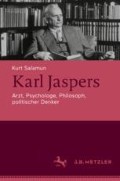Zusammenfassung
Die Hauptwerke von Jaspers sind ins Englische, Französische, Italienische, Spanische und Japanische übersetzt. Auszüge davon, sowie Artikel und Aufsätze wurden in mehr als 32 Sprachen übersetzt, darunter ins Arabische, Chinesische, Dänische, Koreanische, Niederländische, Persische, Polnische, Portugiesische, Russische, Schwedische, Serbokroatische, Türkische und Ungarische. Die internationale Rezeption von Jaspers’ Philosophie wird auch durch internationale Konferenzen gefördert, die von nationalen Jaspers-Gesellschaften kontinuierlich veranstaltet werden. Solche gibt es in: Deutschland, Italien, Japan, Österreich, Polen, der Schweiz, Slowenien, sowie den U.S.A. (Jaspers Society of North America).
Access this chapter
Tax calculation will be finalised at checkout
Purchases are for personal use only
Notes
- 1.
Vgl. Christian Rabanus (Hg.), Primärbibliographie der Schriften Karl Jaspers’, Tübingen, Basel 2000, 337–366.
- 2.
Vgl. Yukio Masubushi, Zur Rezeption von Jaspers’ Philosophie in Japan als Philosophie der existentiellen Vernunft. In: Jb. der Österreichischen Karl-Jaspers-Gesellschaft, Jg. 5 (1992), 54–56.
- 3.
Vgl. Young do Chung, Karl Jaspers und Lao-tse. Parallelen zwischen den Begriffen der Transzendenz und Tao. In: Jb. der Österreichischen Karl-Jaspers-Gesellschaft, Jg. 11 (1998), 28–43; Young do Chung, Jaspers’s Interpretation of Lao-tzu. In: Kurt Salamun, Gregory J. Walters (eds.), Karl Jaspers’s Philosophy: Expositions and Interpretations, Amhurst 2008, 313–321.
- 4.
Vgl. Sawako Hanyu, Jaspers’s Interpretation of Confucius. In: Kurt Salamun, Gregory J. Walters (eds.), Karl Jaspers’s Philosophy: Expositions and Interpretations, Amhurst 2008, 331.
- 5.
Vgl. Kazuteru Fukui, Zur Rezeption und Resonanz von Karl Jaspers’ Philosophie in Japan. In: Reinhard Schulz, Giandomenico Bonanni u. a. (Hg.), „Wahrheit ist, was uns verbindet“, Karl Jaspers’ Kunst zu Philosophieren, Göttingen 2009, 340–342.
- 6.
Vgl. Ram Adar Mall, Philosophie im Vergleich der Kulturen. Interkulturelle Philosophie – eine neue Orientierung, Darmstadt 1996, 159; Ram Adar Mall, Interkulturelle Philosophie und deren Ansätze bei Jaspers. In: Reiner Wiehl, Dominic Kaegi (Hg.), Karl Jaspers – Philosophie und Politik, Heidelberg 1999, 145–162; Andreas Cesana, Karl Jaspers und die Herausforderung der interkulturellen Philosophie. In: Jb. der Österreichischen Karl-Jaspers-Gesellschaft, Jg. 13 (2000), 69–87.
- 7.
Vgl. Indu Sarin, Karl Jaspers and Asian Thought. Buddha and Nagarjuna. In: Kurt Salamun, Gregory J. Walters (eds.), Karl Jaspers’s Philosophy: Expositions and Interpretations, 291–310; Indu Sarin, The Global Vision/Karl Jaspers, Bern 2009, 179–204.
- 8.
Zur Jaspers-Rezeption in Italien vgl. auch: Stefania Achella, Karl Jaspers in Italien vor und nach 1945. In: Offener Horizont. Jahrbuch der Karl Jaspers-Gesellschaft, 2, 2015, hg. von Matthias Bormuth, Göttingen 2015, 58–65.
- 9.
Vgl. Gabriel Marcel, Grundsituation und Grenzsituation bei Karl Jaspers. In: Hans Saner (Hg.), Karl Jaspers in der Diskussion, München 1973, 155–180.
- 10.
Paul Ricoeur, Philosophie und Religion bei Karl Jaspers. In: Paul A. Schilpp (Hg.), Karl Jaspers, Stuttgart 1957, 604–635.
- 11.
Vgl. Jeanne Hersch, Karl Jaspers, Lausanne 1978.
- 12.
Vgl. Jean-Claude Gens, Karl Jaspers. Biographie, Paris 2003.
- 13.
Vgl. Charles F. Wallraff, Karl Jaspers. An Introduction to His Philosophy, Princeton 1970; Oswald O. Schrag, Existence, Existenz, and Transcendence. An Introduction to the Philosophy of Karl Jaspers, Pittsburgh 1971; Leonhard H. Ehrlich, Karl Jaspers: Philosophy as Faith, Amherst 1975; Alan M. Olson, Transcendence and Hermeneutics: An Interpretation of the Philosophy of Karl Jaspers, Boston 1979; Elisabeth Young-Bruehl, Freedom and Karl Jaspers’ Philosophy, New Haven 1981; Gregory J. Walters, Karl Jaspers and the Role of „Conversion“ in the Nuclear Age, Lanham 1987.
- 14.
Vgl. Chris Thornhill, Karl Jaspers. Politics and metaphysics, London, New York 2002.
- 15.
Vgl. Jürgen Habermas, Philosophisch-politische Profile, 31981, 79–109.
- 16.
Vgl. Hans-Martin Gerlach, Existenzphilosophie und Politik. Kritische Auseinandersetzung mit Karl Jaspers, Berlin (DDR) 1974, 78–92.
- 17.
Vgl. Ram Adar Mall, Philosophie im Vergleich der Kulturen. Interkulturelle Philosophie – eine neue Orientierung, Darmstadt 1996, 159.
- 18.
Vgl. Andreas Cesana, Karl Jaspers und die Herausforderung der interkulturellen Philosophie. In: Jb. der Österreichischen Karl-Jaspers-Gesellschaft, 13 (2000), 86.
- 19.
Vgl. Shmuel N. Eisenstadt, The origins and diversity of axial age civilisations, Albany 1986; Shmuel N. Eisenstadt, Axial civilisations and world history, Leiden 2005; Shmuel N. Eisenstadt, Kulturen der Achsenzeit: Ihre Ursprünge und ihre Vielfalt, Frankfurt 1967.
- 20.
Hans Joas, Robert N. Bellah (eds.), The Axial Age and its Consequences for Subsequent History and the Present, Cambrigde MA. 2012; vgl. auch: Hans Joas, Was ist die Achsenzeit? Eine wissenschaftliche Debatte als Diskurs über Transzendenz, Basel 2014.
- 21.
Jan Assmann, Karl Jaspers’ Theorie der Achsenzeit als kulturanalytische Heuristik. In: Offener Horizont. Jahrbuch der Karl Jaspers-Gesellschaft, 4/2017, hg. von Matthias Bormuth, Göttingen 2017, 53.
- 22.
Jan Assmann, Achsenzeit – Eine Archäologie der Moderne, München 2018.
Author information
Authors and Affiliations
Corresponding author
Rights and permissions
Copyright information
© 2019 Springer-Verlag GmbH Deutschland, ein Teil von Springer Nature
About this chapter
Cite this chapter
Salamun, K. (2019). Wirkung und Aktualität. In: Karl Jaspers. J.B. Metzler, Stuttgart. https://doi.org/10.1007/978-3-476-04998-8_13
Download citation
DOI: https://doi.org/10.1007/978-3-476-04998-8_13
Published:
Publisher Name: J.B. Metzler, Stuttgart
Print ISBN: 978-3-476-04997-1
Online ISBN: 978-3-476-04998-8
eBook Packages: J.B. Metzler Humanities (German Language)

